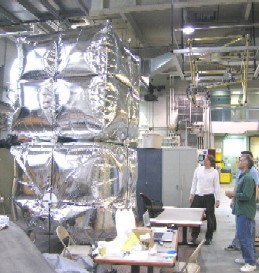Giant Helium Catoms
Big Surfaces to Manipulate Tiny Forces
A Giant Helium Catom (GHC) measures eight cubic meters when its light Mylar skin fills with helium to acquire a lifting force of approximately 5.6 kilograms. This lift is necessary to elevate a frame of carbon fiber rods and plastic joints, which contains the balloon and carries electronic sensors and a communication package to actuate the catom 's motion and engage it with other GHCs. The roughly square balloon is constructed with edge dimensions of approximately 1.9 meters from 4 meter X 1 meter sheets of Mylar. Each balloon uses four sheets of this material.

The Giant Helium Catom provides researchers a macroscale instrument to investigate physical forces that affect microscale devices. The GHC was designed to approximate the relationship between a near-zero-mass (or weightless) particle and the force of electro-magnetic fields spread across the surface of such particles. Such studies are needed to understand the influence of surface tensions on the engineering of interfaces for nanoscale devices.
In addition to its role as a test-bed for nanoscale surface tensions, the great helium catom also offers a prototype design for a low-mass system of robotic self-assembly that can be used at life-scale in solar system travel. Because of its very low mass, it was conceived also as a macroscale construction system for delivery by space craft. Such a system would deploy dwellings and workstations on the Moon and the planet Mars in advance of astronauts who would occupy the pre-constructed stations for long-term exploration and interplanetary travel.
On each face, the GHC cube carries a novel electrostatic latching system that enables the device to move across the faces of other catoms and to communicate with them. The design for this latch system centers on a thin aluminum foil flap across each of the 12 edges of the Mylar cube. This is essentially a square that crosses each of the catom 's edges on a diagonal in order to create two triangular flaps lying at a right angle to each other against the two adjacent surfaces of the catom. With this arrangement, each surface of the catom has four triangular flaps with peaks pointed toward the center of the face.
Among the six faces, the triangular flaps provide each catom with the means to form an electrostatic latch with another cube from 24 positions - providing the cubes with a capacity to move at right angles in any direction. In addition to motion, the latches also equip the GHC with the means to communicate across the ensemble of catoms. In the drawing below, one Giant Helium Catom pivots across the surface of another, revealing the positions and attachments of triangular electrostatic flaps.

Two electrodes on each flap create the electrostatic forces that enable latches to form a capacitive couple between flaps on adjacent GHCs. A dielectric material (Mylar) isolates the pair of electrodes (and electrical charges from them) on each flap to prevent their direct electrical contact. This design enables voltage differences applied to the electrodes to accumulate charges, create electrostatic force on the flap and align with electrodes that carry an opposing charge on the flap of an adjacent GHC.
Each flap moves independently with the assistance of a spring-loaded mechanism and a composite shape-memory alloy (SMA). GHCs deliver power to each other using capacitive coupling with alternating current (AC). The AC power generated at the neighboring catom is rectified and regulated, and the resulting DC power is used for processing and other electronics on the module. A high-voltage generator creates the electrostatic force to activate the latches.
Although the project planned to construct six giant helium catoms to simulate an ensemble, in its 3-month duration, this experiment tested this interface on two catoms.
Experience with this design provided the Carnegie Mellon-Intel Claytronics Research Project with substantial experience in the design characteristics of micro-electro-mechanical latches.
For additional views of the Giant Helium Catom and more discussion of its functionality, read these design notes .
Publications and Documents
NOT FOUND: "Ultralight Modular Robotic Building Blocks for the Rapid Deployment of Planetary Outposts,
